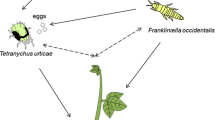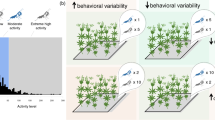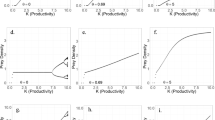Abstract
Interactions between predators foraging in the same patch may strongly influence patch use and functional response. In particular, there is continued interest in how the magnitude of mutual interference shapes predator–prey interactions. Studies commonly focus on either patch use or the functional response without attempting to link these important components of the foraging puzzle. Predictions from both theoretical frameworks suggest that predators should modify foraging efforts in response to changes in feeding rate, but this prediction has received little empirical attention. We study the linkage between patch departure rates and food consumption by the hunting spider, Pardosa milvina, using field enclosures in which prey and predator densities were manipulated. Additionally, the most appropriate functional response model was identified by fitting alternative functional response models to laboratory foraging data. Our results show that although prey availability was the most important determinant of patch departure rates, a greater proportion of predators left enclosures containing elevated predator abundance. Functional response parameter estimation revealed significant levels of interference among predators leading to lower feeding rates even when the area allocated for each predator was kept constant. These results suggest that feeding rates determine patch movement dynamics, where interference induces predators to search for foraging sites that balance the frequency of agonistic interactions with prey encounter rates.


Similar content being viewed by others
References
Abrams PA (2007) Habitat choice in predator-prey systems: spatial instability due to interacting adaptive movements. Am Nat 169:581–594. doi:10.1086/512688
Abrams PA (2010) Implications of flexible foraging for interspecific interactions: lessons from simple models. Funct Ecol 24:7–17. doi:10.1111/j.1365-2435.2009.01621.x
Abrams PA, Ginzburg LR (2000) The nature of predation: prey dependent, ratio dependent or neither? Trends Ecol Evol 15:337–341. doi:10.1016/s0169-5347(00)01908-x
Anderson JJ (2010) Ratio- and predator-dependent functional forms for predators optimally foraging in patches. Am Nat 175:240–249. doi:10.1086/649606
Arditi R, Akcakaya HR (1990) Underestimation of mutual interference of predators. Oecologia 83:358–361
Arditi R, Ginzburg LR (1989) Coupling in predator prey dynamics-ratio-dependence. J Theor Biol 139:311–326. doi:10.1016/s0022-5193(89)80211-5
Arditi R, Ginzburg LR (2012) How species interact: altering the standard view of trophic ecology. Oxford University Press, New York
Beddington JR (1975) Mutual interference between parasites or predators and its effect on searching efficiency. J Anim Ecol 44:331–340. doi:10.2307/3866
Brown JS (1988) Patch use as an indicator of habitat preference, predation risk, and competition. Behav Ecol Sociobiol 22:37–47. doi:10.1007/bf00395696
Buddle CN, Rypstra AL (2003) Factors initiating emigration of two wolf spider species (Araneae: Lycosidae) in an agroecosystem. Environ Entomol 32:88–95. doi:10.1603/0046-225x-32.1.88
Charnov EL, Orians GH, Hyatt K (1976) Ecological implications of resource depression. Am Nat 110:247–259. doi:10.1086/283062
Crowley PH, Martin EK (1989) Functional-responses and interference within and between year classes of a dragonfly population. J N Am Benthol Soc 8:211–221. doi:10.2307/1467324
Deangelis DL, Goldstein RA, Oneill RV (1975) Model for trophic interaction. Ecology 56:881–892. doi:10.2307/1936298
DeLong JP, Vasseur DA (2011) Mutual interference is common and mostly intermediate in magnitude. BMC Ecol 11:1
DeLong JP, Vasseur DA (2013) Linked exploitation and interference competition drives the variable behavior of a classic predator-prey system. Oikos 122:1393–1400
Dondale CD, Redner JH (1990) The insects and arachnids of Canada. Part 17. The wolf spiders, nurseryweb spiders, and lynx spiders of Canada and Alaska. Agriculture Canada, Ottawa
Ford MJ (1978) Locomotory activity and the predation strategy of the wolf spider Pardosa amentata (Clerck) (Lycosidae). Anim Behav 26:31–35. doi:10.1016/0003-3472(78)90005-2
Fryxell JM (2013) The great predator-prey debate. Ecology 94:1206–1207
Fryxell JM, Falls JB, Falls EA, Brooks RJ, Dix L, Strickland MA (1999) Density dependence, prey dependence, and population dynamics of martens in Ontario. Ecology 80:1311–1321. doi:10.1890/0012-9658(1999)080[1311:ddpdap]2.0.co;2
Hassell MP, Varley GC (1969) New inductive population model for insect parasites and its bearing on biological control. Nature 223:1133–2000. doi:10.1038/2231133a0
Hastie TJ, Pregibon D (1992) Generalized linear models. Wadsworth and Brooks/Cole, California
Holling CS (1961) Principles of insect predation. Annu Rev Entomol 6:163–200. doi:10.1146/annurev.en06.010161.001115
Iwasa Y, Higashi M, Yamamura N (1981) Prey distribution as a factor determining the choice of optimal foraging strategy. Am Nat 117:710–723. doi:10.1086/283754
Jensen CXJ, Ginzburg LR (2005) Paradoxes or theoretical failures? The jury is still out. Ecol Model 188:3–14. doi:10.1016/j.ecolmodel.2005.05.001
Kimbrell T, Holt RD, Lundberg P (2007) The influence of vigilance on intraguild predation. J Theor Biol 249:218–234. doi:10.1016/j.jtbi.2007.07.031
Krivan V, Schmitz OJ (2003) Adaptive foraging and flexible food web topology. Evol Ecol Res 5:623–652
Langellotto GA, Denno RF (2004) Responses of invertebrate natural enemies to complex-structured habitats: a meta-analytical synthesis. Oecologia 139:1–10. doi:10.1007/s00442-004-1497-3
Laundre JW, Hernandez L, Altendorf KB (2001) Wolves, elk, and bison: reestablishing the “landscape of fear” in Yellowstone National Park, USA. Can J Zool-Rev Can Zool 79:1401–1409. doi:10.1139/cjz-79-8-1401
Lopez-Bao JV, Palomares F, Rodriguez A, Ferreras P (2011) Intraspecific interference influences the use of prey hotspots. Oikos 120:1489–1496. doi:10.1111/j.1600-0706.2011.19194.x
Lotka AJ (1925) Elements of physical biology. Williams and Wilkins, Baltimore
Marshall SD, Walker SE, Rypstra AL (2000) A test for a differential colonization and competitive ability in two generalist predators. Ecology 81:3341–3349. doi:10.1890/0012-9658(2000)081[3341:atfadc]2.0.co;2
Marshall SD, Pavuk DM, Rypstra AL (2002) A comparative study of phenology and daily activity patterns in the wolf spiders Pardosa milvina and Hogna helluo in soybean agroecosystems in southwestern Ohio (Araneae, Lycosidae). J Arachnol 30:503–510. doi:10.1636/0161-8202(2002)030[0503:acsopa]2.0.co;2
Marshall SD, Walker SE, Rypstra AL (2006) Two ecologically-divergent generalist predators have different responses to landscape fragmentation. Oikos 114:241–248. doi:10.1111/j.2006.0030-1299.14115.x
Nyffeler M, Sterling WL, Dean DA (1994) How spiders make a living. Environ Entomol 23:1357–1367
Perry G, Pianka ER (1997) Animal foraging: past, present and future. Trends Ecol Evol 12:360–364. doi:10.1016/s0169-5347(97)01097-5
Pinheiro JC, Bates DM (2000) Mixed-effects models in S and S-PLUS. Springer, New York Berlin Heidelberg
R Core Team (2013) R: a language and environment for statistical computing. R Foundation for Statistical Computing, Vienna
Riechert SE, Lockley T (1984) Spiders as biological-control agents. Annu Rev Entomol 29:299–320. doi:10.1146/annurev.ento.29.1.299
Rypstra AL, Samu F (2005) Size dependent intraguild predation and cannibalism in coexisting wolf spiders (Araneae, Lycosidae). J Arachnol 33:390–397. doi:10.1636/ct05-10.1
Rypstra AL, Schmidt JM, Reif BD, DeVito J, Persons MH (2007) Tradeoffs involved in site selection and foraging in a wolf spider: effects of substrate structure and predation risk. Oikos 116:853–863. doi:10.1111/j.2007.0030-1299.15622.x
Samu F, Sziranyi A, Kiss B (2003) Foraging in agricultural fields: local ‘sit-and-move’ strategy scales up to risk-averse habitat use in a wolf spider. Anim Behav 66:939–947. doi:10.1006/anbe.2003.2265
Schmidt JM, Rypstra AL (2010) Opportunistic predator prefers habitat complexity that exposes prey while reducing cannibalism and intraguild encounters. Oecologia 164:899–910. doi:10.1007/s00442-010-1785-z
Sih A (1984) The behavioral response race between predator and prey. Am Nat 123:143–150. doi:10.1086/284193
Skalski GT, Gilliam JF (2001) Functional responses with predator interference: viable alternatives to the Holling type II model. Ecology 82:3083–3092. doi:10.1890/0012-9658(2001)082[3083:frwpiv]2.0.co;2
Stephens DW, Brown JS, Ydenberg RC (2007) Foraging: behevior and ecology. University of Chicago Press, Chicago
Sutherland WJ (1992) Game-theory models of functional and aggregative responses. Oecologia 90:150–152. doi:10.1007/bf00317820
van der Meer J, Ens BJ (1997) Models of interference and their consequences for the spatial distribution of ideal and free predators. J Anim Ecol 66:846–858
Walker SE, Rypstra AL (2002) Sexual dimorphism in trophic morphology and feeding behavior of wolf spiders (Araneae: Lycosidae) as a result of differences in reproductive roles. Can J Zool 80:679–688. doi:10.1139/z02-037
Wise DH (2006) Cannibalism food limitation intraspecific competition and the regulation of spider populations. Annu Rev Entomol 51:441–465
Young OP, Edwards GB (1990) Spiders in United States field crops and their potential effect on crop pests. J Arachnol 18:1–27
Acknowledgments
We thank Sam Evans and other undergraduate research assistants for help with the set-up of experiments and animal care. Michael Sitvarin kindly contributed comments on an early draft of the manuscript. This research was funded by the Department of Zoology (both Hamilton and Oxford, Ohio campuses), and we thank the Rodney Kolb for helping with field management at the Ecology Research Center at Miami University.
Author information
Authors and Affiliations
Corresponding author
Additional information
Communicated by Thomas S. Hoffmeister.
Electronic supplementary material
Below is the link to the electronic supplementary material.
Rights and permissions
About this article
Cite this article
Schmidt, J.M., Crist, T.O., Wrinn, K. et al. Predator interference alters foraging behavior of a generalist predatory arthropod. Oecologia 175, 501–508 (2014). https://doi.org/10.1007/s00442-014-2922-x
Received:
Accepted:
Published:
Issue Date:
DOI: https://doi.org/10.1007/s00442-014-2922-x




